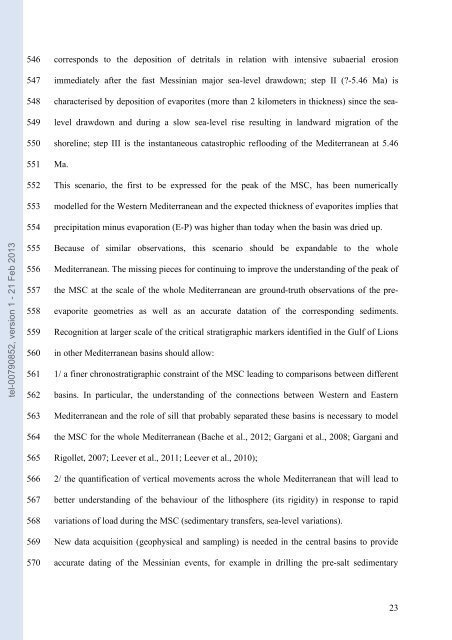Quantification des flux sédimentaires et de la subsidence du bassin ...
Quantification des flux sédimentaires et de la subsidence du bassin ...
Quantification des flux sédimentaires et de la subsidence du bassin ...
You also want an ePaper? Increase the reach of your titles
YUMPU automatically turns print PDFs into web optimized ePapers that Google loves.
tel-00790852, version 1 - 21 Feb 2013<br />
546<br />
547<br />
548<br />
549<br />
550<br />
551<br />
552<br />
553<br />
554<br />
555<br />
556<br />
557<br />
558<br />
559<br />
560<br />
561<br />
562<br />
563<br />
564<br />
565<br />
566<br />
567<br />
568<br />
569<br />
570<br />
corresponds to the <strong>de</strong>position of d<strong>et</strong>ritals in re<strong>la</strong>tion with intensive subaerial erosion<br />
immediately after the fast Messinian major sea-level drawdown; step II (?-5.46 Ma) is<br />
characterised by <strong>de</strong>position of evaporites (more than 2 kilom<strong>et</strong>ers in thickness) since the sea-<br />
level drawdown and <strong>du</strong>ring a slow sea-level rise resulting in <strong>la</strong>ndward migration of the<br />
shoreline; step III is the instantaneous catastrophic reflooding of the Mediterranean at 5.46<br />
Ma.<br />
This scenario, the first to be expressed for the peak of the MSC, has been numerically<br />
mo<strong>de</strong>lled for the Western Mediterranean and the expected thickness of evaporites implies that<br />
precipitation minus evaporation (E-P) was higher than today when the basin was dried up.<br />
Because of simi<strong>la</strong>r observations, this scenario should be expandable to the whole<br />
Mediterranean. The missing pieces for continuing to improve the un<strong>de</strong>rstanding of the peak of<br />
the MSC at the scale of the whole Mediterranean are ground-truth observations of the pre-<br />
evaporite geom<strong>et</strong>ries as well as an accurate datation of the corresponding sediments.<br />
Recognition at <strong>la</strong>rger scale of the critical stratigraphic markers i<strong>de</strong>ntified in the Gulf of Lions<br />
in other Mediterranean basins should allow:<br />
1/ a finer chronostratigraphic constraint of the MSC leading to comparisons b<strong>et</strong>ween different<br />
basins. In particu<strong>la</strong>r, the un<strong>de</strong>rstanding of the connections b<strong>et</strong>ween Western and Eastern<br />
Mediterranean and the role of sill that probably separated these basins is necessary to mo<strong>de</strong>l<br />
the MSC for the whole Mediterranean (Bache <strong>et</strong> al., 2012; Gargani <strong>et</strong> al., 2008; Gargani and<br />
Rigoll<strong>et</strong>, 2007; Leever <strong>et</strong> al., 2011; Leever <strong>et</strong> al., 2010);<br />
2/ the quantification of vertical movements across the whole Mediterranean that will lead to<br />
b<strong>et</strong>ter un<strong>de</strong>rstanding of the behaviour of the lithosphere (its rigidity) in response to rapid<br />
variations of load <strong>du</strong>ring the MSC (sedimentary transfers, sea-level variations).<br />
New data acquisition (geophysical and sampling) is nee<strong>de</strong>d in the central basins to provi<strong>de</strong><br />
accurate dating of the Messinian events, for example in drilling the pre-salt sedimentary<br />
23

















